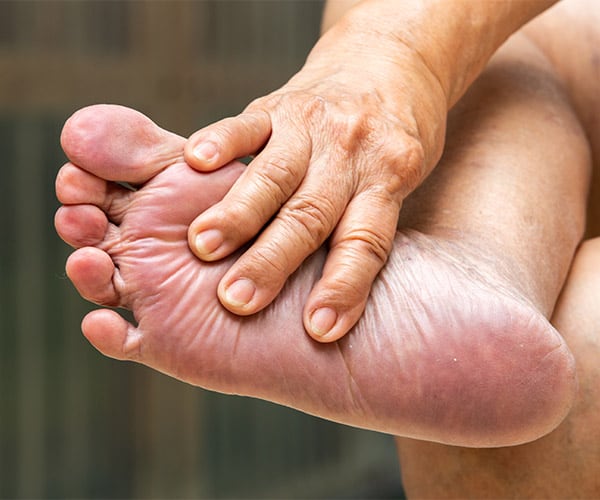Diabetes and Your Feet
Diabetes and Your Feet
Nervous system damage (also called neuropathy) affects 60-70% of people with diabetes and is a major complication that may cause a loss of feeling in hands or feet.
With diabetic feet, a wound as small as a blister from ill-fitting shoes can cause a lot of damage. Diabetes impacts your circulatory system which means injuries are slow to heal. Furthermore, diabetics often have reduced sensation in their feet, so an injury may go unnoticed. When a wound doesn’t heal, it’s at an increased risk for infections that can spread quickly.
Areas of high pressure, like the ball of your feet, heels and tips of your toes, are especially susceptible to developing corns and calluses that may ulcerate and become wounds. Chiropodists are highly skilled in reducing calluses and corns to prevent these wounds from developing, as well as treating a variety of other diabetic foot issues.

- Treatment
- Effects
- Foot Care
Treatment for Diabetic Foot Problems
There are a number of treatments for diabetic foot problems. At Collective Foot and Wellness Clinic, we can perform a diabetic foot assessment to determine the best treatment options for you. Options include:
- Nail care including thick, fungal, and ingrown nails
- Corn and callus reduction and offloading
- Orthopedic shoe fitting
- Custom foot orthotics
- Wound care
Effects of Diabetes on Feet
The most common effects of diabetes on feet are:
- Neuropathy or numbness in the feet
- Poor circulation or lack of blood flow
- Burning or tingling
- Dry skin
- Ulcerations on areas of high pressure
- Claw toes
- Wounds that do not heal
If left untreated, small issues can quickly become large problems in diabetic feet. Wounds or ulcerations may not heal fully, leading to infections and possible gangrene. According to the Canadian Associate of Wound Care, 85% of all amputations are due to non-healing foot ulcers. More than half of these amputations could have been prevented with proper footwear and diabetic foot care.
Each year, hundreds of Ontarians have a limb operation due to non-healing foot ulcers and improper foot care. Don’t be a statistic. Prevent serious diabetic foot problems with proper foot care and treatment.
Diabetic Foot Care
There are many measures you can take to help avoid diabetic foot problems:
- Keep your blood sugar between 5 and 7
- Check your feet daily (for puncture wounds, bruises, pressure areas, redness, warmth, blisters, ulcers, scratches, cuts, and nail problems)
- Always wear proper footwear or custom foot orthotics
- Keep feet clean and dry
- Apply foot lotion
- Wear white, cotton socks with no seams or elastics
- Walk and keep active
For more information, visit:
Canadian Association of Wound Care
Canadian Diabetes Association
Contact Collective Foot and Wellness Clinic for your assessment today. Let’s get started correcting and preventing your diabetic foot problems!
